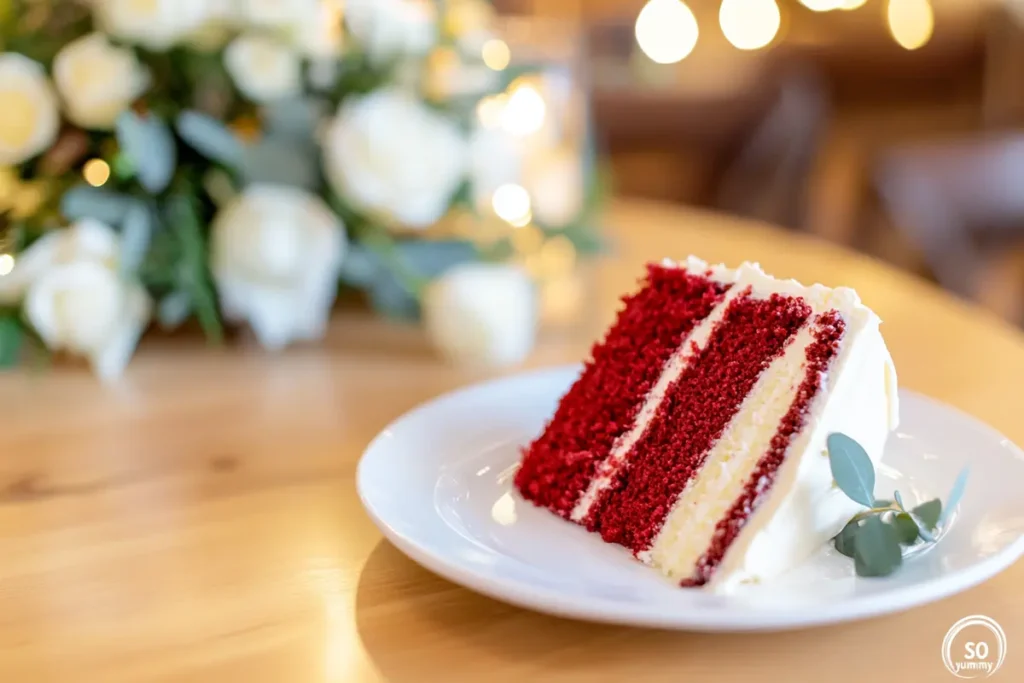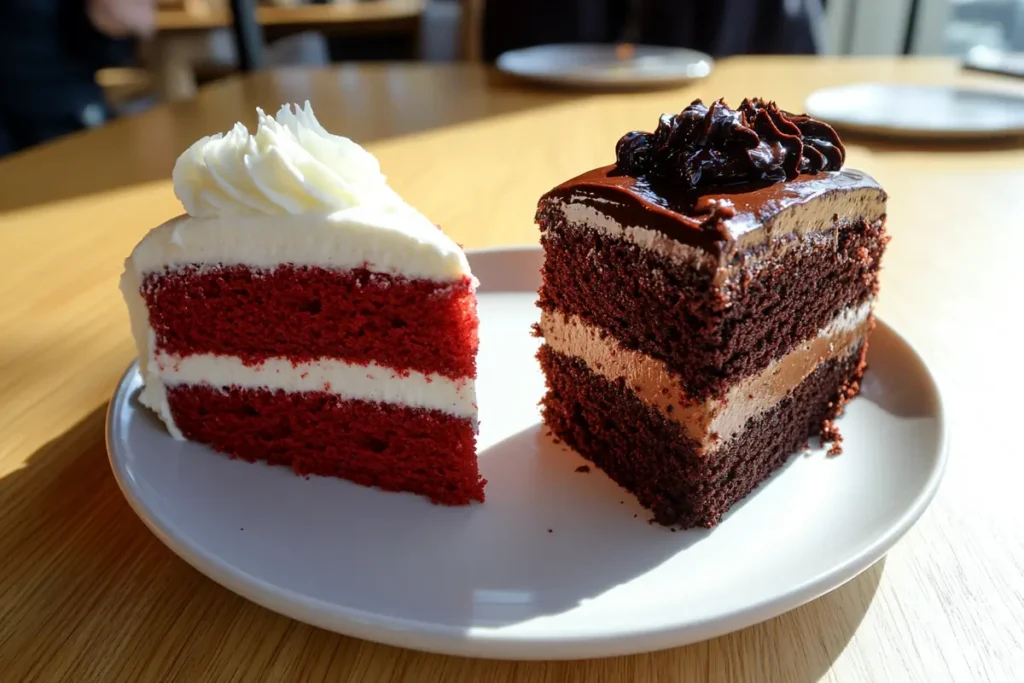
Red velvet cake and chocolate cake are two beloved desserts, each with its own fan base and unique flavor profile. While they may share some similarities, such as their use of cocoa powder and their soft, moist textures, red velvet cake is not just a chocolate cake dyed red. The subtle differences in ingredients, preparation, and taste make red velvet a distinct confection. In this detailed guide, we’ll explore what makes red velvet cake taste different from chocolate cake and why it stands out as a dessert on its own.
Introduction
Red velvet cake is often mistaken for a chocolate cake simply because it contains cocoa powder. However, its flavor is more nuanced and complex, blending subtle hints of chocolate with tangy and buttery undertones. This leads many to wonder: What makes red velvet cake taste different from chocolate cake? Let’s dive into the ingredients, baking techniques, and other factors that create these unique flavors.
Key Ingredients: The Building Blocks of Flavor
- Chocolate Cake: Typically, chocolate cakes rely on a larger quantity of cocoa powder or melted chocolate for their deep, rich flavor. The result is a robust, chocolate-forward taste that dominates the palate.
- Red Velvet Cake: In contrast, red velvet cake uses a smaller amount of cocoa powder—usually 1–2 tablespoons. This gives it only a subtle chocolate undertone that doesn’t overpower the other flavors in the cake.
The cocoa powder in red velvet cake contributes more to its complexity than to its primary flavor, making it distinct from the full-bodied chocolate flavor of traditional chocolate cakes.
2. Acidic Components: Buttermilk and Vinegar
- Chocolate Cake: While chocolate cakes may include milk or water, they rarely feature acidic ingredients like buttermilk or vinegar. This keeps their flavor profile straightforward and focused on the chocolate.
- Red Velvet Cake: The combination of buttermilk and vinegar is what sets red velvet apart. These ingredients react with baking soda to create a tender, airy texture and lend the cake its tangy flavor. This tanginess is a signature characteristic of red velvet cake, offering a balance to its mild chocolate notes.
3. Sugar: Balancing Sweetness
- Both cakes use sugar as a sweetener, but the overall flavor balance differs due to the additional ingredients in red velvet cake. While chocolate cake focuses solely on amplifying chocolate’s richness, red velvet’s sweetness is often counterbalanced by its tangy and creamy elements.
4. Food Coloring: The Iconic Red Hue
- Chocolate Cake: Chocolate cake relies entirely on cocoa powder or melted chocolate for its deep brown color.
- Red Velvet Cake: The vibrant red hue of red velvet cake, achieved through food coloring or beet juice, is one of its defining features. Historically, the reaction between natural cocoa powder and acidic ingredients would create a reddish tint, but modern recipes often enhance this effect with red food dye.
5. Fat: Butter vs. Oil
- Chocolate Cake: Chocolate cakes often use oil as the primary fat, contributing to their moistness and light texture.
- Red Velvet Cake: Red velvet cake traditionally uses butter, which adds a rich, creamy flavor and a denser crumb compared to chocolate cake.
Taste Profile: Chocolate Cake vs. Red Velvet Cake

1. Chocolate Cake: Rich and Decadent
Chocolate cake has a bold, pronounced chocolate flavor that comes from the generous use of cocoa or melted chocolate. The texture can range from dense and fudgy to light and airy, depending on the recipe, but the flavor is always rich and unmistakably chocolatey.
2. Red Velvet Cake: Subtle and Complex
Red velvet cake, on the other hand, is characterized by its mild cocoa flavor, tangy undertones, and buttery richness. The interplay of these elements creates a more nuanced taste that is less sweet and intense than chocolate cake.
Texture Differences
Chocolate Cake
Chocolate cake is usually moist and soft, with a lighter crumb when made with oil. The higher fat content contributes to its richness, and it pairs beautifully with buttercream or ganache.
Red Velvet Cake
Red velvet cake is known for its velvety texture (hence the name), which is achieved through the reaction of acidic ingredients with baking soda. This texture is slightly denser than that of chocolate cake, but still tender and moist.
The Role of Frosting
Chocolate Cake Frosting
Chocolate cake is commonly paired with chocolate frosting or ganache to enhance its chocolate-forward flavor. Variations like vanilla buttercream or cream cheese frosting are used less frequently but still complement the rich chocolate base.
Red Velvet Cake Frosting
Red velvet cake is almost always frosted with cream cheese frosting. The tanginess of the frosting mirrors and amplifies the tangy flavor of the cake, creating a harmonious balance. This pairing is one of the reasons red velvet cake stands out from chocolate cake.
Historical Origins of Red Velvet Cake
Red velvet cake originated during the Victorian era as a luxurious dessert served at formal occasions. Its “velvety” texture was a result of fine cake flour and acidic components. The addition of cocoa powder provided a subtle chocolate flavor, while the use of vinegar and buttermilk gave it its unique tanginess.
Chocolate cake, on the other hand, became popular in the late 19th century with the invention of Dutch-processed cocoa, which allowed for a deeper, richer chocolate flavor.
Cultural Significance
While chocolate cake is a universal favorite that fits into virtually any occasion, red velvet cake has a more niche appeal. Its eye-catching red color and distinctive flavor make it a popular choice for weddings, Valentine’s Day, and holidays like Christmas.
Baking Techniques That Make Red Velvet Unique
1. The Acid Reaction
The acidic components in red velvet cake (buttermilk and vinegar) not only affect the flavor but also contribute to its unique texture. This reaction helps to create a soft, tender crumb that differentiates it from the oil-based structure of chocolate cake.
2. Food Coloring
Modern red velvet cakes use red food coloring to achieve their vibrant hue. However, some bakers opt for natural alternatives like beet juice for a more subtle, earthy tint.
3. Balanced Sweetness
Red velvet cake often includes less sugar compared to chocolate cake, allowing its tangy and buttery flavors to shine.
How to Tell the Difference at First Bite
When tasting the two cakes side by side, the differences are apparent:
- Flavor: Chocolate cake offers an intense chocolate flavor, while red velvet cake is mild, tangy, and buttery with just a hint of cocoa.
- Texture: Red velvet cake has a denser, velvety texture compared to the lighter crumb of most chocolate cakes.
- Frosting: The tangy cream cheese frosting of red velvet cake contrasts sharply with the sweet, chocolatey toppings typical of chocolate cake.
Pairing Suggestions
For Chocolate Cake
- Beverages: Pair with coffee, milk, or a robust red wine.
- Toppings: Enhance with fresh berries or a drizzle of caramel sauce.
For Red Velvet Cake
- Beverages: Match with a glass of milk, cream liqueur, or sparkling wine.
- Toppings: Complement with fresh strawberries or a sprinkle of powdered sugar.
Frequently Asked Questions
1. Is Red Velvet Cake Just Chocolate Cake Dyed Red?
No. While red velvet cake contains cocoa powder, it has a distinct flavor profile due to the addition of buttermilk, vinegar, and other ingredients that create a tangy, nuanced taste.
2. Can I Substitute Red Velvet for Chocolate Cake in Recipes?
Technically, you can, but the flavor and texture will be noticeably different. Red velvet cake requires specific ingredients and techniques that cannot be replicated by simply adding food coloring to a chocolate cake recipe.
3. Why Is Red Velvet Cake So Popular?
Its unique flavor, soft texture, and vibrant color make it stand out. The tangy cream cheese frosting further enhances its appeal.
4. Can You Make Red Velvet Cake Without Food Coloring?
Yes. Historically, red velvet cakes were made without food coloring, relying on the reaction between cocoa powder and acidic ingredients for their reddish hue.
5. Which Cake Is Healthier: Red Velvet or Chocolate?
Neither cake is particularly healthy, but red velvet cakes often contain less sugar and chocolate, making them slightly lighter in terms of calorie content.
Conclusion
So, what makes red velvet cake taste different from chocolate cake? The answer lies in its unique combination of subtle chocolate notes, tangy undertones, and buttery richness. The use of buttermilk, vinegar, and cream cheese frosting elevates red velvet cake beyond the realm of a simple chocolate dessert. With its distinct flavor, velvety texture, and striking appearance, red velvet cake truly stands out as a dessert masterpiece. Whether you’re a fan of bold chocolate flavors or crave the nuanced complexity of red velvet, there’s no denying that each cake offers a unique and delightful experience.
Enjoy baking and tasting the best of both worlds!